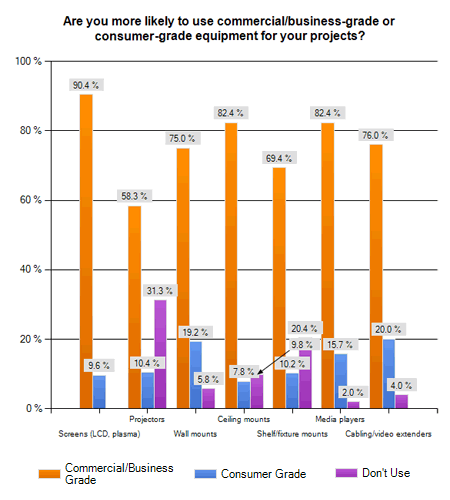What are the benefits of commercial-grade digital signage equipment?
Between all the bloggers in our industry, dozens of articles have been written about the advantages of using commercial-grade hardware. Typically, these focus on screens and media players -- the two most obvious hardware components of a digital signage network. Arguments for going "pro" have included extended service life, better reliability (and thus less downtime), more serviceable components, better service options (like on-site repair and hot spare replacement), and not voiding your warranty by simply using the device in a commercial space (a common issue with consumer-grade screens, in particular). Some things like commercial mounting brackets also have different liability insurance options, so if the bracket fails and a screen drops from the ceiling and injures someone, the network owner is less likely to be on the hook (maybe).
While all of these things were true five years ago, some are less so today. For example, the service life for many consumer and commercial screens is identical these days. The reliability of consumer-grade screens and PC hardware has also grown by leaps and bounds as demand for these devices has grown (and consumer tolerance for malfunction has waned). Combined, these factors have driven down the demand -- and the perceived value -- of superior service and replacement options. That's why I was so surprised to see our survey respondents overwhelmingly indicate their preference for commercial-grade equipment, as evidenced by this graph:

Why are so many people choosing commercial equipment?
As much as I'd like to pretend it's because people have been listening to industry bloggers like myself, I don't think we've had that much to do with shaping people's preferences for commercial hardware. Instead, we can thank the manufacturers of commercial-grade screens, who have done an excellent job of advertising some of the chief features and benefits of their pro-grade units, especially when compared to some of their consumer models. Ironically, the slow pace of many digital signage deployments has probably helped their efforts: many consumer TVs and computers from big PC makers have short lifecycles, which can force deployments that span several years to swap between different models as older ones are discontinued. Commercial units, on the other hand, are typically available for much longer stretches, giving network owners the opportunity to use consistent equipment for the life of their project.
Another factor that's probably driving the use of commercial equipment is, ironically, hardware commoditization. Innumerable consumers and businesses have been purchasing flat screens, computers, mounts and previously high-end AV equipment, leading to two important results. First, the components used by these systems have become more reliable and less expensive. Second, the price premium between consumer and commercial systems has also decreased, due to increased sharing of parts. Increased pressure from increasingly capable lower-end systems has also forced vendors to innovate and add more and better features to their pro lines. As the price premiums shrink and the incremental features become more valuable, commercial-grade hardware will continue to be ideal for a large number of customers.
When doesn't it make sense to use commercial equipment?
Interestingly, with so much growth in the digital signage market coming from smaller networks that have relatively modest needs, there are probably more legitimate uses for consumer grade equipment in digital signage projects than ever before. For example, projects that only require a few screens and players won't see the value of long product life cycles. Systems placed in easily serviced locations make it harder to justify the cost of on-site warranty repair plans. And of course, those who simply couldn't do a project at all unless it's at the lowest possible cost will be better off with all consumer-grade equipment than no equipment at all (though arguably some people just shouldn't be doing these projects to begin with).
So, while much of our industry continues its race to the bottom, it looks like display makers and equipment vendors have done a good job communicating the value of their higher-end (and higher-margin) equipment. Even in light of the increasing adoption of digital signage by smaller organizations -- a segment which might be well enough served by consumer-grade components -- professional equipment continues to be the standard for many. Unfortunately, we won't know which way this trend is heading until we ask the same question in our 2011 pricing survey. In the meantime...
Will the bulk of projects in 2011 continue to use pro-grade equipment, or are commodity parts "good enough" for most projects today? Leave a comment below and tell us what you think!

 Subscribe to the Digital Signage Insider RSS feed
Subscribe to the Digital Signage Insider RSS feed
Comments
RSS feed for comments to this post